Verdict
The THX Onyx’s ability to deliver clear, detailed sound is its biggest plus, good for music, films and games at home or on-the-go.
Pros
- Exciting, lively performance
- MQA support
- More affordable than it was at launch
- Works with music, film/TV and games
Cons
- Can overplay its hand if not in the right mode for PCs
Availability
- UKRRP: £149.99
- USARRP: $149.99
- EuropeRRP: €199.99
- CanadaRRP: CA$269.99
- AustraliaRRP: AU$359.95
-
Headset mic supportSupports microphones on PC, Mac and Android -
MQACan natively playback Tidal Master files -
Impedence range22 ohms to 1000 ohms
Introduction
THX has been associated with sound for nearly forty years, starting in the realm of cinema when it was created by Thomlinson Holman at Lucasfilm before being spun-off into its current incarnation in the early 2000s.
The company has certified audio for theatres, computer speakers, car audio systems and video games but until recently they’ve stayed on the professional side of the electronics market.
The Onyx is a DAC/headphone amplifier aimed at those who watch films, stream TV and play games. The specs sound impressive on paper but despite THX’s undoubted pedigree, can it replicate its success in the consumer market?
Design
- Durable body
- Full colour RGB light system
- Magnetic cable
The Onyx’s sleek shape consists of three parts. The DAC is contained within the all-metal CNC-machined body, then there’s a flexible rubbery part that terminates in a USB-C port with a USB-A adapter that can be slotted on top.
The 3.5mm/USB-A connections offer plug and play connectivity to laptops, PCs, headphones and even desktop speakers and stereo amplifiers. USB-C allows the Onyx to connect to Android, Mac and iOS devices with a USB-C port. For iOS devices with a Lightning port, the USB Lightning to Camera adapter is needed for full compatibility.
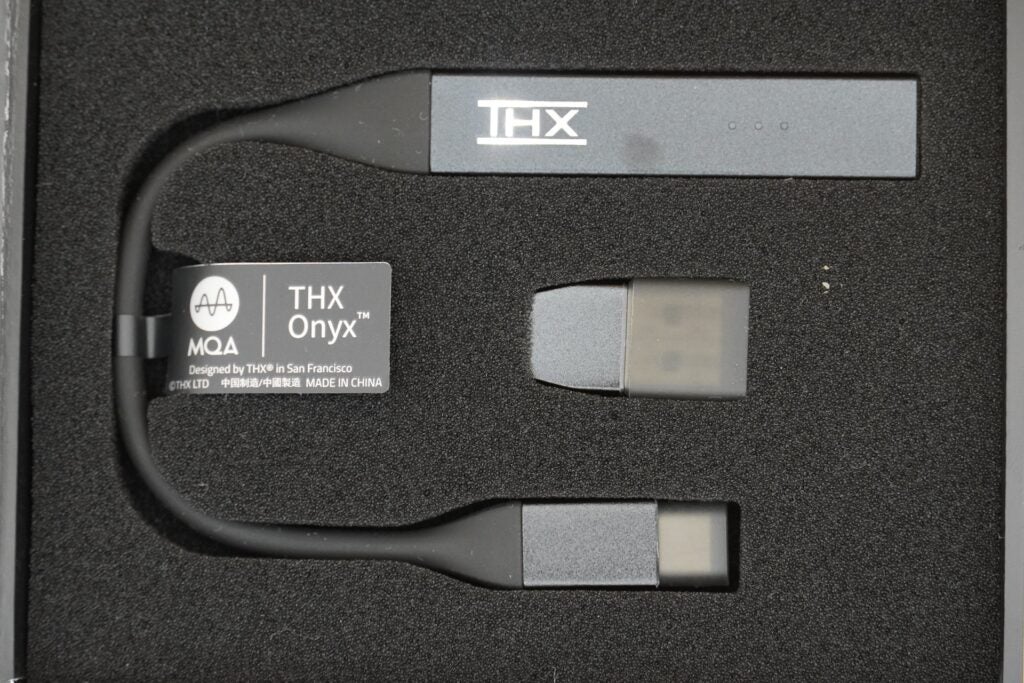
The flexible rubber part makes the Onyx more compact to use when out of the house – it can fold back over itself like a snake coiling its body with its magnetic cable.
The main body (which can run a little warm during use) has a full colour RGB light system that reveals current playback mode. Blue is standard quality (44.1 or 48kHz PCM), yellow is High Resolution audio (greater than 48kHz PCM), red is DSD (Direct Stream Digital), and purple is MQA (Tidal Masters). It’s easy to grasp and useful visual feedback when a service isn’t playing at the quality you know it to be.
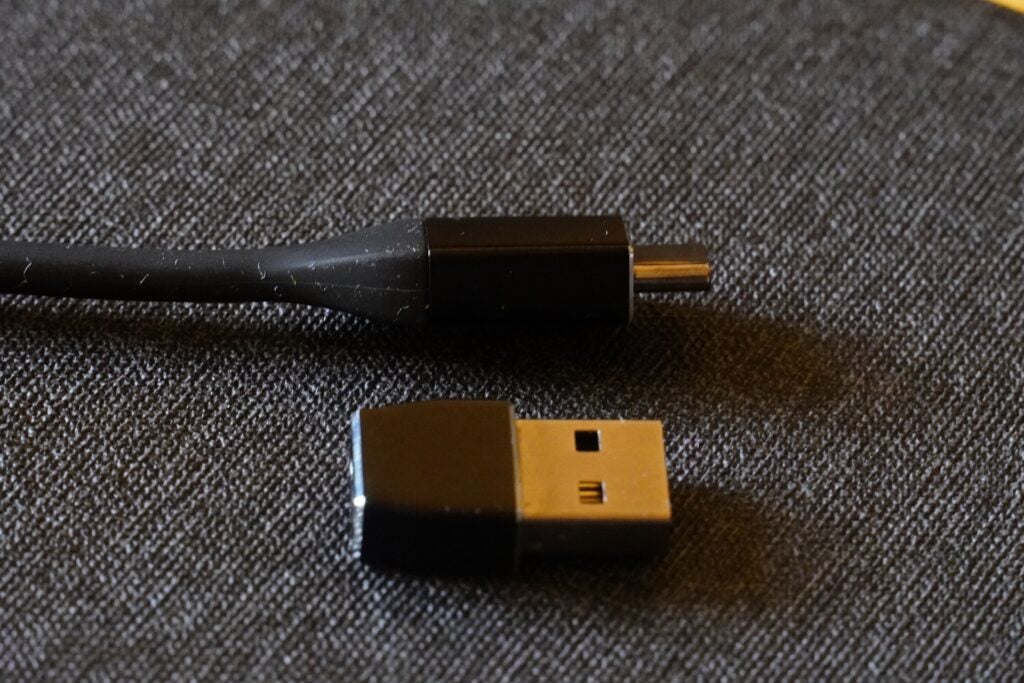
Only wired headphones and headsets with TRS/TRRS jack are supported, and THX claims the Onyx can improve the audio performance of a headphones’ attached microphone, which comes in handy for PC gaming. A headphone with a TRRS terminated cable is needed for fully functioning microphone support.
Features
- Low THD+N distortion
- Hi-Res Audio file support
- MQA certified renderer
The Onyx boasts THX’s Achromatic Audio Amplifier. This intends to produce the highest fidelity possible with low levels of noise – its THD+N (Total Harmonic Distortion) figure is 112dB (or 0.00025%) – and that should help make music listening a less fatiguing and cleaner-sounding one.
THX claims the AAA-78 (by its full name) is also capable of matching the power of desktop AAA/DAC/amp, enabling maximum output power, improved dynamic range and greater sound pressure level.
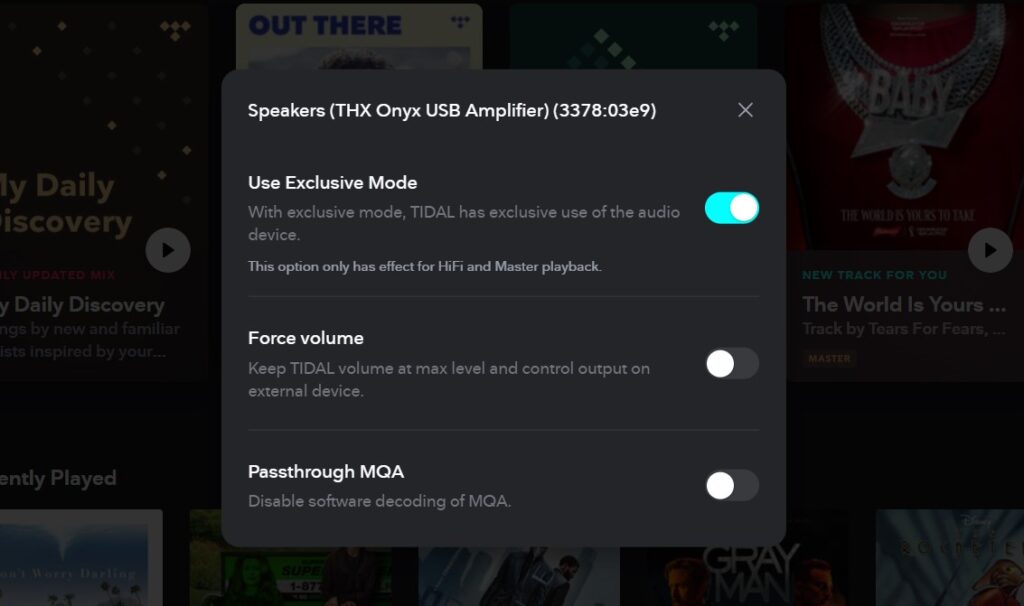
The DAC at its heart is the ESS ES9281PRO, the first USB product to have integration with Master Quality Authenticated (MQA) audio. The Onyx has an MQA renderer that performs the second ‘unfold’ to unpack all the data within a file for the best audio quality. Currently, Tidal’s premium Hi-Fi tier and US-based nugs.net are the only music streaming services that support MQA.
Power throughput is calculated at 180mW, which THX says can drive headphone impedances from 22 to 1000 Ohms – although headphones rarely peak above 600 Ohms. File support equals PCM up to 32-bit 384kHz, DSD (64 and 128 files) and MQA tracks up to 384kHz.
Sound Quality
- Clean, detailed and energetic sound
- Improved dynamism
- Good with a variety of sources
The figures the THX Onyx boast are impressive on paper and in reality, I found the Onyx produced an engaging performance, though listening to Qobuz on desktop did require tweaking of the settings for the best performance.
At first, I would have described the Onyx’s performance as fatiguing on my Windows laptop, especially over longer listening sessions. Fiddling with the volume calms the Onyx’s tendencies with its power delivery but there are more decisive changes to be done by changing the sound modes on Qobuz. Switching to Wasapi Exclusive resulted in a less fatiguing listen, and once I’d done that, I much enjoyed the performance gains the Onyx brought about.
Used with the Sivga Robin SV021 and a Lenovo laptop as a means of comparing the laptop’s DAC to the Onyx, the THX betters the laptop’s DAC in dispensing a more energetic delivery, opening up the soundstage and producing a more assertive bass performance.
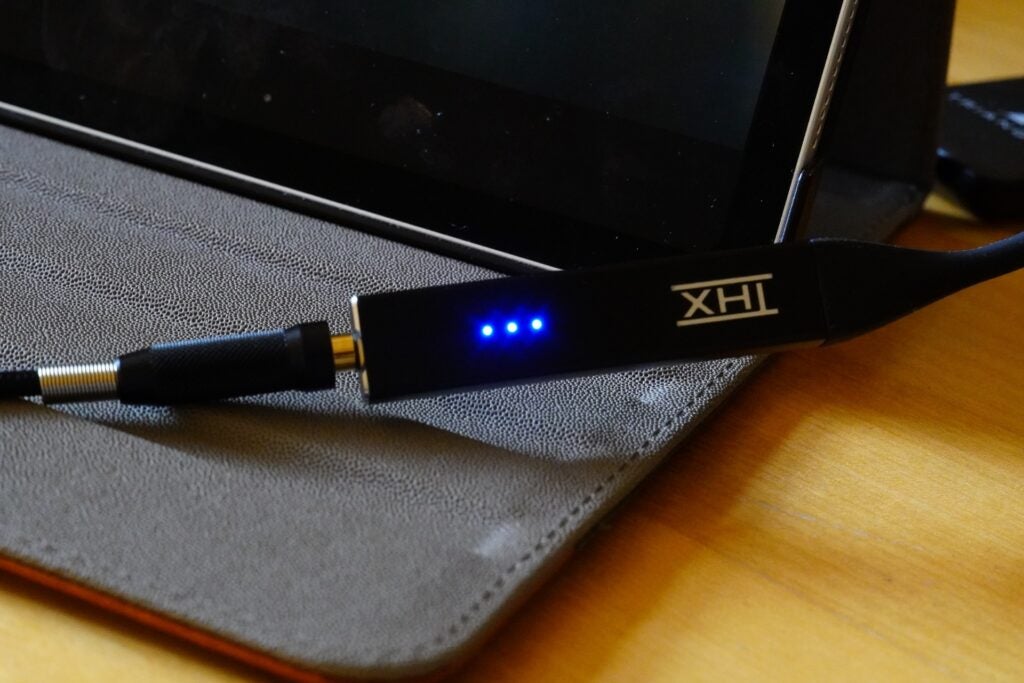
With Okvsho’s Descrobrir playing on Qobuz, the percussive beats that punctuate the track are granted a more defined presence within the soundstage. The sound is bigger and the separation between instruments is audibly clearer, with better definition that lends a more natural and realistic tone to how the trumpet sounds in the track.
Moving to Bear McCreary’s soundtrack for Foundation, and the tinkly treble notes of the piano that open the first track are better emphasized, with more subtlety and variation in the tone of the piano, and again the separation between the instruments of the track is clearer. The soundstage opens up, offering more detail than I heard by just using the SV021 connected to the laptop.
With the SV021, the track felt more of a stereo affair – left and right imaging but not too much in-between. The Onyx organizes the soundstage to be more engaging, bigger and with more depth, shuffling sounds into the middle, which again helps with the sense of space.
Bass is strongly emphasized but not at the expense of the track’s overall balance, and there’s more variation to the lower end frequencies which sounded a little one-note with headphones. There’s more dynamic headroom not just in the difference between quiet and louder notes – which is much starker – but in that there’s power to low end of the frequency range and more brightness at the other end.
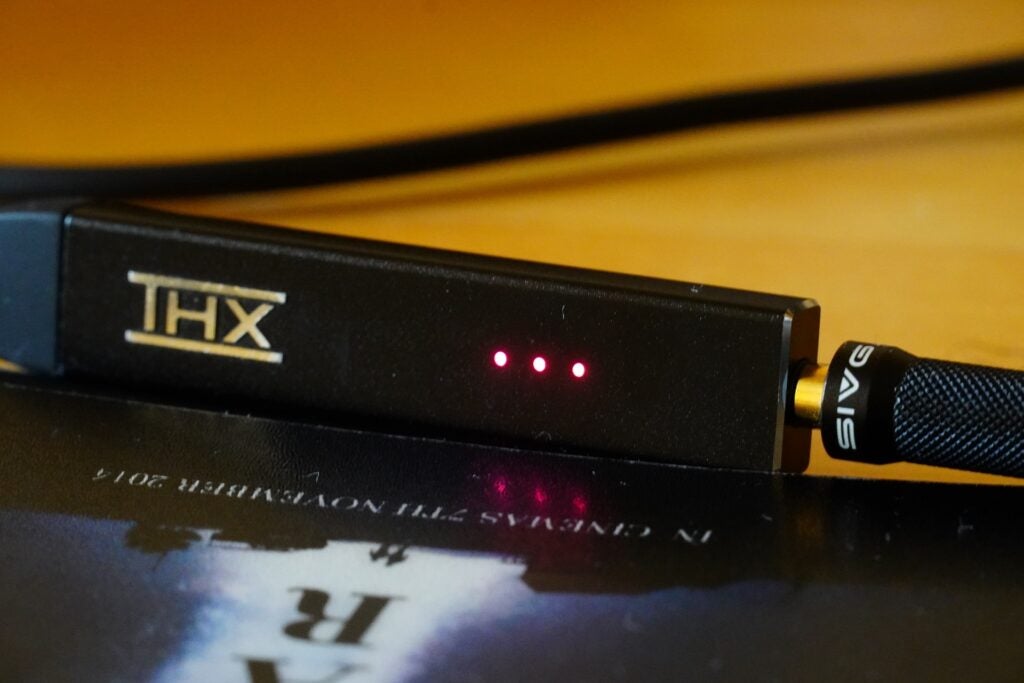
A play of David Bowie’s Young Americans and the gains are obvious to pick up. The drums sound bigger and hit harder, adding more texture and variation to the track; the saxophone sounds sweeter, and the cymbals crash with more energy and crispness. It’s the type of performance that gets my fingers tapping on the desk.
Everything sounds bigger, from the voices to the instruments, although with Young Americans the soundstage didn’t feel as wide, and the backing vocals sounded a little cramped as a result. Nevertheless, there’s more detail to be uncovered and more to hear, which is only a good thing in my book.
Compared with the EarMen Eagle, a listen of London Grammar’s California Soil sounds crisper on the EarMen with its more neutral tone, but the THX offers a better overall listen by applying more detail and definition to instruments along with better depth and separation with voices too. The dynamic range is also more assertively pitched by the THX than it is with the (cheaper) Eagle.
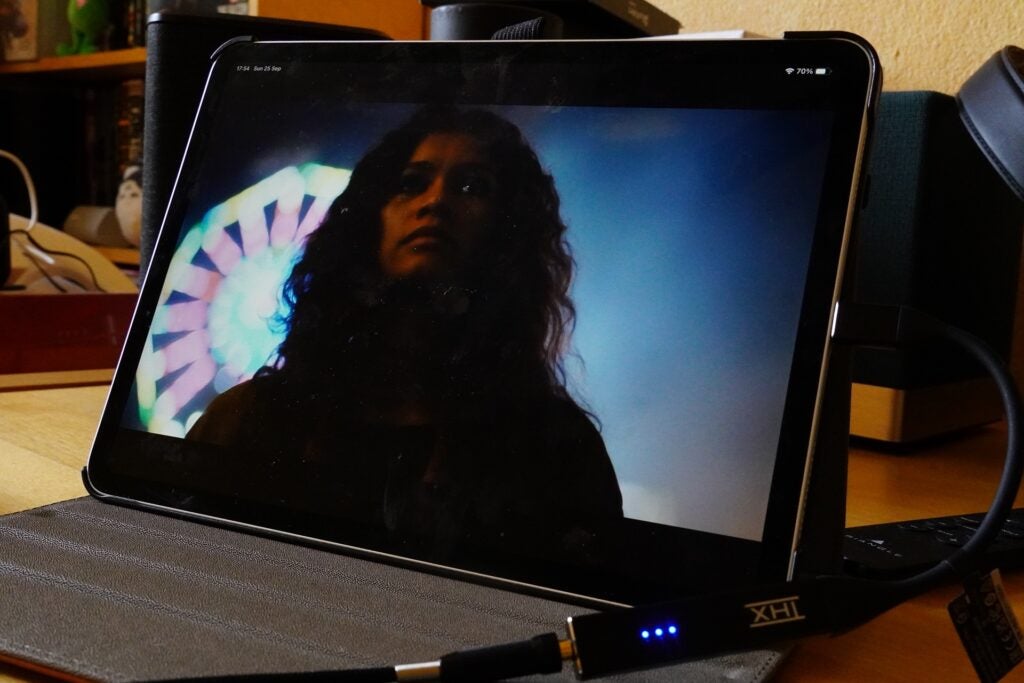
Continuing on the comparison by watching Euphoria on an iPad Pro and the Onyx describes bass with more weight and digs up more detail with dialogue smoother than it was with the Eagle.
Switching gears to a mobile game – Sayonara Wild Hearts via Apple Arcade – and upon closer inspection, there’s a tinge of more brightness to high frequency notes and more intensity to the music. There’s a little more excitement and enthusiasm with the THX attached than there was with the EarMen, which sums up its performance in a nutshell.
Latest deals
Should you buy it?
For the excitement it brings to audio: With Qobuz on a desktop its worth sifting through the sound settings to find the best mode, but in general, the Onyx delivers more excitement, detail and dynamism than cheaper DACs and suffices as upgrade over those models.
If you are after something more affordable: The extra refinement and excitement may not be a big incentive to choose the Onyx over a more affordable DAC, but this is the ‘cheapest’ the Onyx has been so far.
Final Thoughts
The THX Onyx provides a welcome, enthusiastic boost to audio. It depicts audio with more clarity, detail and energy, and does so without overegging the pudding.
The range of file formats it supports is good for high-end playback, the design is smart and there’s MQA certification for those who subscribe to Tidal Hi-Fi. At a more affordable price point than when it first launched, the THX Onyx’s versatility makes it a good option for music lovers, film fans and gamers.
How we test
We test every DAC we review thoroughly over an extended period of time. We use industry-standard tests to compare features properly. We’ll always tell you what we find. We never, ever, accept money to review a product.
Find out more about how we test in our ethics policy.
Tested over several weeks
Tested with deskop, iOS devices
Tested with music streaming services
FAQs
You can use the Onyx DAC with an iPhone but you’ll need the Lightning USB Camera Adapter for full compatibility.
Sustainability
Trusted Reviews’ holds the fact that global warming is not a myth as a core value and will continuously endeavour to help protect our planet from harm in its business practices.
As part of this mission, whenever we review a product we send the company a series of questions to help us gauge and make transparent the impact the device has on the environment.
We currently haven’t received answers to the questions on this product, but will update this page the moment we do. You can see a detailed breakdown of the questions we ask and why in our sustainability info page
Verdict
The THX Onyx’s ability to deliver clear, detailed sound is its biggest plus, good for music, films and games at home or on-the-go.
Pros
- Exciting, lively performance
- MQA support
- More affordable than it was at launch
- Works with music, film/TV and games
Cons
- Can overplay its hand if not in the right mode for PCs
Availability
- UKRRP: £149.99
- USARRP: $149.99
- EuropeRRP: €199.99
- CanadaRRP: CA$269.99
- AustraliaRRP: AU$359.95
-
Headset mic supportSupports microphones on PC, Mac and Android -
MQACan natively playback Tidal Master files -
Impedence range22 ohms to 1000 ohms
Introduction
THX has been associated with sound for nearly forty years, starting in the realm of cinema when it was created by Thomlinson Holman at Lucasfilm before being spun-off into its current incarnation in the early 2000s.
The company has certified audio for theatres, computer speakers, car audio systems and video games but until recently they’ve stayed on the professional side of the electronics market.
The Onyx is a DAC/headphone amplifier aimed at those who watch films, stream TV and play games. The specs sound impressive on paper but despite THX’s undoubted pedigree, can it replicate its success in the consumer market?
Design
- Durable body
- Full colour RGB light system
- Magnetic cable
The Onyx’s sleek shape consists of three parts. The DAC is contained within the all-metal CNC-machined body, then there’s a flexible rubbery part that terminates in a USB-C port with a USB-A adapter that can be slotted on top.
The 3.5mm/USB-A connections offer plug and play connectivity to laptops, PCs, headphones and even desktop speakers and stereo amplifiers. USB-C allows the Onyx to connect to Android, Mac and iOS devices with a USB-C port. For iOS devices with a Lightning port, the USB Lightning to Camera adapter is needed for full compatibility.

The flexible rubber part makes the Onyx more compact to use when out of the house – it can fold back over itself like a snake coiling its body with its magnetic cable.
The main body (which can run a little warm during use) has a full colour RGB light system that reveals current playback mode. Blue is standard quality (44.1 or 48kHz PCM), yellow is High Resolution audio (greater than 48kHz PCM), red is DSD (Direct Stream Digital), and purple is MQA (Tidal Masters). It’s easy to grasp and useful visual feedback when a service isn’t playing at the quality you know it to be.

Only wired headphones and headsets with TRS/TRRS jack are supported, and THX claims the Onyx can improve the audio performance of a headphones’ attached microphone, which comes in handy for PC gaming. A headphone with a TRRS terminated cable is needed for fully functioning microphone support.
Features
- Low THD+N distortion
- Hi-Res Audio file support
- MQA certified renderer
The Onyx boasts THX’s Achromatic Audio Amplifier. This intends to produce the highest fidelity possible with low levels of noise – its THD+N (Total Harmonic Distortion) figure is 112dB (or 0.00025%) – and that should help make music listening a less fatiguing and cleaner-sounding one.
THX claims the AAA-78 (by its full name) is also capable of matching the power of desktop AAA/DAC/amp, enabling maximum output power, improved dynamic range and greater sound pressure level.

The DAC at its heart is the ESS ES9281PRO, the first USB product to have integration with Master Quality Authenticated (MQA) audio. The Onyx has an MQA renderer that performs the second ‘unfold’ to unpack all the data within a file for the best audio quality. Currently, Tidal’s premium Hi-Fi tier and US-based nugs.net are the only music streaming services that support MQA.
Power throughput is calculated at 180mW, which THX says can drive headphone impedances from 22 to 1000 Ohms – although headphones rarely peak above 600 Ohms. File support equals PCM up to 32-bit 384kHz, DSD (64 and 128 files) and MQA tracks up to 384kHz.
Sound Quality
- Clean, detailed and energetic sound
- Improved dynamism
- Good with a variety of sources
The figures the THX Onyx boast are impressive on paper and in reality, I found the Onyx produced an engaging performance, though listening to Qobuz on desktop did require tweaking of the settings for the best performance.
At first, I would have described the Onyx’s performance as fatiguing on my Windows laptop, especially over longer listening sessions. Fiddling with the volume calms the Onyx’s tendencies with its power delivery but there are more decisive changes to be done by changing the sound modes on Qobuz. Switching to Wasapi Exclusive resulted in a less fatiguing listen, and once I’d done that, I much enjoyed the performance gains the Onyx brought about.
Used with the Sivga Robin SV021 and a Lenovo laptop as a means of comparing the laptop’s DAC to the Onyx, the THX betters the laptop’s DAC in dispensing a more energetic delivery, opening up the soundstage and producing a more assertive bass performance.

With Okvsho’s Descrobrir playing on Qobuz, the percussive beats that punctuate the track are granted a more defined presence within the soundstage. The sound is bigger and the separation between instruments is audibly clearer, with better definition that lends a more natural and realistic tone to how the trumpet sounds in the track.
Moving to Bear McCreary’s soundtrack for Foundation, and the tinkly treble notes of the piano that open the first track are better emphasized, with more subtlety and variation in the tone of the piano, and again the separation between the instruments of the track is clearer. The soundstage opens up, offering more detail than I heard by just using the SV021 connected to the laptop.
With the SV021, the track felt more of a stereo affair – left and right imaging but not too much in-between. The Onyx organizes the soundstage to be more engaging, bigger and with more depth, shuffling sounds into the middle, which again helps with the sense of space.
Bass is strongly emphasized but not at the expense of the track’s overall balance, and there’s more variation to the lower end frequencies which sounded a little one-note with headphones. There’s more dynamic headroom not just in the difference between quiet and louder notes – which is much starker – but in that there’s power to low end of the frequency range and more brightness at the other end.

A play of David Bowie’s Young Americans and the gains are obvious to pick up. The drums sound bigger and hit harder, adding more texture and variation to the track; the saxophone sounds sweeter, and the cymbals crash with more energy and crispness. It’s the type of performance that gets my fingers tapping on the desk.
Everything sounds bigger, from the voices to the instruments, although with Young Americans the soundstage didn’t feel as wide, and the backing vocals sounded a little cramped as a result. Nevertheless, there’s more detail to be uncovered and more to hear, which is only a good thing in my book.
Compared with the EarMen Eagle, a listen of London Grammar’s California Soil sounds crisper on the EarMen with its more neutral tone, but the THX offers a better overall listen by applying more detail and definition to instruments along with better depth and separation with voices too. The dynamic range is also more assertively pitched by the THX than it is with the (cheaper) Eagle.

Continuing on the comparison by watching Euphoria on an iPad Pro and the Onyx describes bass with more weight and digs up more detail with dialogue smoother than it was with the Eagle.
Switching gears to a mobile game – Sayonara Wild Hearts via Apple Arcade – and upon closer inspection, there’s a tinge of more brightness to high frequency notes and more intensity to the music. There’s a little more excitement and enthusiasm with the THX attached than there was with the EarMen, which sums up its performance in a nutshell.
Latest deals
Should you buy it?
For the excitement it brings to audio: With Qobuz on a desktop its worth sifting through the sound settings to find the best mode, but in general, the Onyx delivers more excitement, detail and dynamism than cheaper DACs and suffices as upgrade over those models.
If you are after something more affordable: The extra refinement and excitement may not be a big incentive to choose the Onyx over a more affordable DAC, but this is the ‘cheapest’ the Onyx has been so far.
Final Thoughts
The THX Onyx provides a welcome, enthusiastic boost to audio. It depicts audio with more clarity, detail and energy, and does so without overegging the pudding.
The range of file formats it supports is good for high-end playback, the design is smart and there’s MQA certification for those who subscribe to Tidal Hi-Fi. At a more affordable price point than when it first launched, the THX Onyx’s versatility makes it a good option for music lovers, film fans and gamers.
How we test
We test every DAC we review thoroughly over an extended period of time. We use industry-standard tests to compare features properly. We’ll always tell you what we find. We never, ever, accept money to review a product.
Find out more about how we test in our ethics policy.
Tested over several weeks
Tested with deskop, iOS devices
Tested with music streaming services
FAQs
You can use the Onyx DAC with an iPhone but you’ll need the Lightning USB Camera Adapter for full compatibility.
Sustainability
Trusted Reviews’ holds the fact that global warming is not a myth as a core value and will continuously endeavour to help protect our planet from harm in its business practices.
As part of this mission, whenever we review a product we send the company a series of questions to help us gauge and make transparent the impact the device has on the environment.
We currently haven’t received answers to the questions on this product, but will update this page the moment we do. You can see a detailed breakdown of the questions we ask and why in our sustainability info page
























